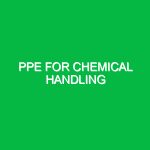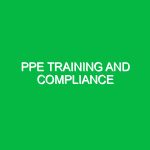Personal Protective Equipment (PPE) plays a crucial role in safeguarding employees from workplace hazards. The inspection and replacement of PPE are vital components of health, safety, and environmental (HSE) management. This process not only ensures compliance with safety regulations but also protects workers’ health and wellbeing. In an era where workplace safety cannot be compromised, understanding the intricacies of PPE inspection and replacement is paramount. This article delves into the importance of these practices, the potential hazards involved, and the best practices to ensure effective PPE management.
Understanding PPE and Its Importance in HSE
PPE encompasses a variety of equipment designed to protect workers from specific hazards in the workplace. This includes helmets, gloves, goggles, respirators, and specialized clothing. The relevance of PPE in HSE cannot be overstated. Effective PPE can minimize the risk of injuries and illnesses, thereby enhancing overall productivity and promoting a culture of safety within organizations. According to the Occupational Safety and Health Administration (OSHA), providing appropriate PPE is a legal requirement, and failure to do so can result in severe penalties.
Moreover, PPE is often the last line of defense when other safety measures, such as engineering controls or administrative procedures, cannot eliminate risks. For instance, a construction worker exposed to falling debris relies on a hard hat for protection. If that hard hat is damaged or outdated, the risk of injury escalates considerably. This scenario highlights the need for regular inspection and timely replacement of PPE to ensure its efficacy.
Identifying Hazards and Risks Associated with PPE Inspection and Replacement
The process of inspecting and replacing PPE is not without its challenges. Various hazards can arise during this essential task, which may compromise safety instead of enhancing it. Here are some of the potential risks:
1. Physical Hazards
Physical hazards can include sharp objects, heavy machinery, and uneven surfaces. For instance, when inspecting fall protection harnesses at a construction site, a worker might encounter loose cables or tools that pose tripping risks. Additionally, lifting heavy PPE items for inspection can lead to musculoskeletal injuries if proper lifting techniques are not employed.
2. Chemical Hazards
In environments where chemicals are present, PPE may become contaminated. For example, a worker inspecting a chemical-resistant suit must be cautious of chemical spills. Improper handling can expose them to hazardous substances, leading to skin irritation or respiratory issues.
3. Biological Hazards
In certain industries, biological hazards are a significant concern. Healthcare workers, for instance, must inspect gloves and masks for integrity before use. A tear or puncture can expose them to pathogens, thus heightening the risk of infection.
4. Psychological Hazards
Underestimating the importance of PPE can lead to complacency, a psychological hazard that might result in negligence. Workers who feel that PPE is unnecessary may skip inspections, increasing the likelihood of using defective equipment.
Safety Precautions and Best Practices for PPE Inspection and Replacement
To mitigate the risks associated with PPE inspection and replacement, organizations must adopt comprehensive safety precautions and best practices. Here are some actionable steps:
1. Develop a PPE Inspection Program
Establishing a structured PPE inspection program is essential. This program should outline inspection procedures, frequency, and responsible personnel. For instance, a common approach is to conduct weekly inspections for high-use equipment, while less frequently used items may require monthly checks.
2. Train Employees
Training is critical in ensuring that employees understand how to properly inspect and maintain their PPE. Regular training sessions can reinforce the importance of PPE and the correct methods of inspection. For example, a construction company might conduct monthly safety meetings that include hands-on training for inspecting harnesses and helmets.
3. Document Inspections
Maintaining detailed records of PPE inspections is crucial for accountability and compliance. Documentation should include the date of inspection, the inspector’s name, findings, and any actions taken. This practice not only helps track the condition of PPE but also serves as evidence of compliance during audits.
4. Replace Defective PPE Promptly
Timely replacement of defective PPE is non-negotiable. If any PPE is found to be damaged during inspection, it should be replaced immediately. For instance, if a pair of safety goggles is scratched or cracked, they should be discarded and replaced before they can be used again. This action prevents accidents and ensures that protective measures are always effective.
5. Establish a Reporting System
Encouraging employees to report any concerns regarding PPE is vital. A simple reporting system can empower workers to voice their concerns without fear of retaliation. For example, a worker noticing that a colleague is using a damaged respirator should feel comfortable reporting it to a supervisor for immediate action.
6. Regular Audits
Conducting regular audits of the PPE program helps identify areas for improvement. During these audits, organizations can evaluate the effectiveness of their inspection processes and make necessary adjustments. This proactive approach ensures that PPE remains a top priority in workplace safety.
Regulations and Standards Governing PPE Inspection and Replacement
Several regulations and standards guide the inspection and replacement of PPE. Understanding these guidelines is essential for compliance and safety. Key regulations include:
1. OSHA Standards
The OSHA standards for PPE (29 CFR 1910 Subpart I) outline the requirements for various types of personal protective equipment. Employers are mandated to assess hazards and provide necessary PPE, ensuring regular inspections and replacements as needed.
2. ANSI Standards
The American National Standards Institute (ANSI) establishes standards for PPE performance and testing. ANSI standards provide guidelines on the design, materials, and testing of PPE, ensuring that equipment meets safety requirements.
3. ISO Standards
The International Organization for Standardization (ISO) provides global standards for PPE. ISO 45001, for instance, focuses on occupational health and safety management systems, emphasizing the need for proper PPE use and maintenance.
Conclusion
The inspection and replacement of PPE are critical components of an effective health, safety, and environmental program. By understanding the potential hazards associated with these processes and adhering to best practices, organizations can significantly reduce risks and protect their workforce. Compliance with regulations and standards further enhances workplace safety. Ultimately, a commitment to diligent PPE inspection and timely replacement not only safeguards employees but also fosters a culture of safety that benefits everyone.


